Iris Eichenberg: Topoanalysis / Wer Bin Ich? will be at the David Klein Gallery in Detroit though Nov. 4, 2023.
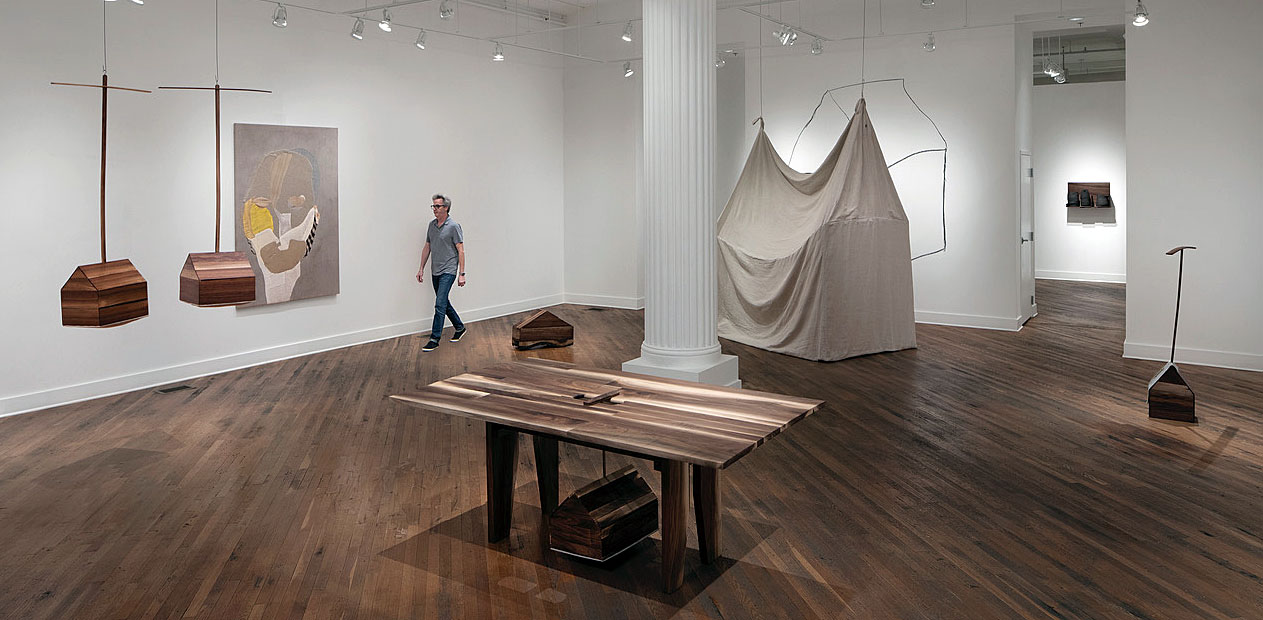
An installation shot of Iris Eichenberg: Topoanalysis / Wer Bin Ich? will be at the David Klein Gallery in Detroit through Nov. 4, 2023. (All images courtesy of David Klein Gallery.)
With Topoanalysis / Wer Bin Ich?, Iris Eichenberg — the German-born, Dutch-educated head of metalsmithing at Cranbrook Academy of Art — continues her probing search for roots and meaning, particularly as found in material objects and places in memory. The solo exhibition will be up at Detroit’s David Klein Gallery until Nov. 4, 2023.
“Topoanalysis” is a term coined by the French philosopher Gaston Bachelard and refers to the psychological study of key sites in our intimate lives. And as the question in the title — “Who am I?” — underlines, this exhibition explores identity and personal history through allegorical representations of people and houses that still echo in Eichenberg’s life.
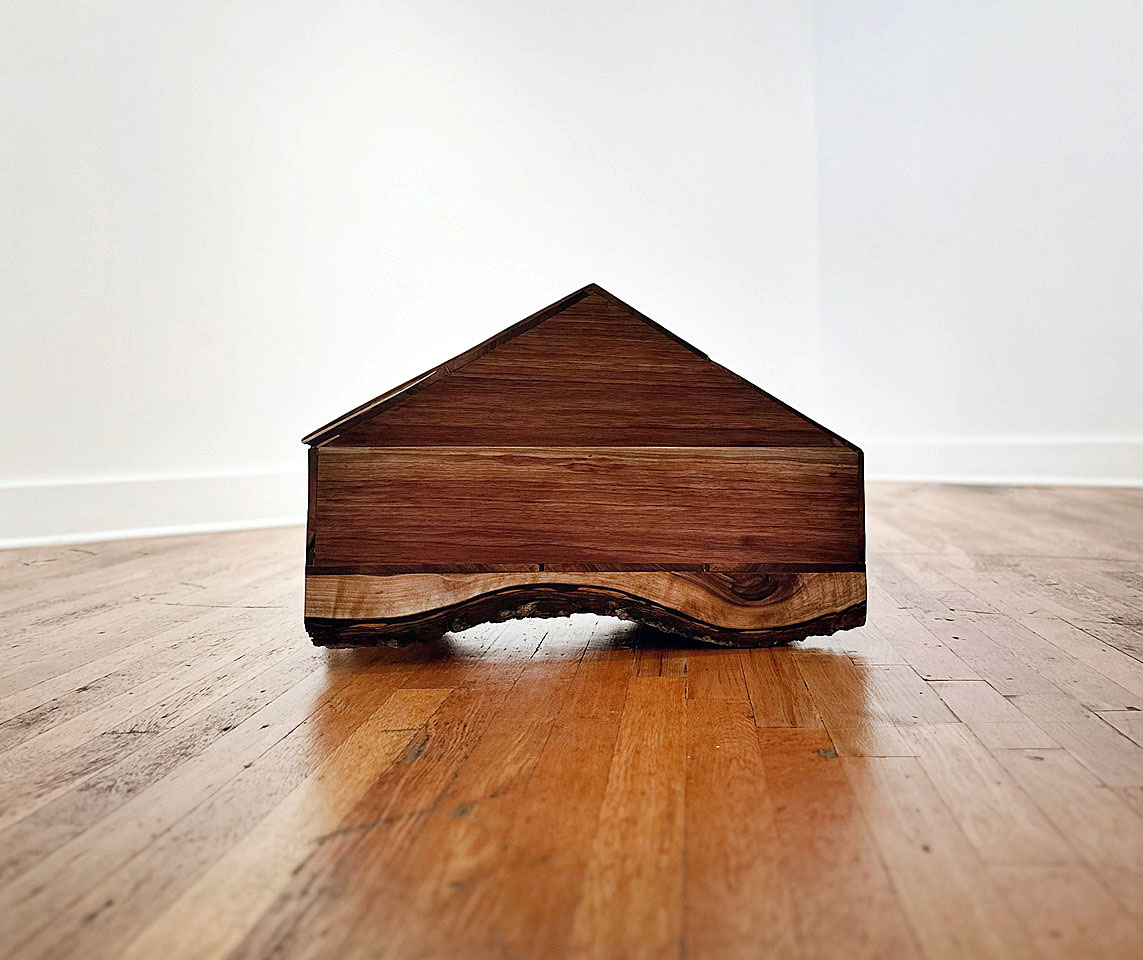
Iris Eichenberg, Academy Way, Wood, bark; 16 ½ by 24 ½ by 10 ½ inches, 2023.
The show comes in three parts, employing very different materials: wood, fabric, and pottery. But this won’t come as a surprise to anyone who’s followed the artist’s career since she first landed in America, at Cranbrook in 2006. Creative tools in Eichenberg’s hands have included materials as disparate as her grandmother’s silk stockings and silver spoons, colorful birds crammed in painful cages, knitted mittens, glistening ceramic vessels, or, in the case of her 2020 show The Center Piece / The Blank, white and dark-gray discs hung from elegant, wide strips of black fabric. From a distance, the wallscape read almost like modernist architecture.
What Eichenberg said in this writer’s first conversation with her 14 years ago is clearly still as apt as it was then, and amounts to a sort of design philosophy: “I always try to encounter and fight with new material.” Indeed she does.
In Topoanalysis, Eichenberg’s constructed simplified “houses” up to a couple feet tall that look a bit like giant versions of children’s blocks. Each structure, rendered in warm, contrasting wood tones, is a stand-in for someplace the artist lived, where memories and emotions are deeply lodged. Some of these houses are attached to poles with a cross-piece or handle at the far end, suggesting, perhaps, that even a house constitutes a tool.
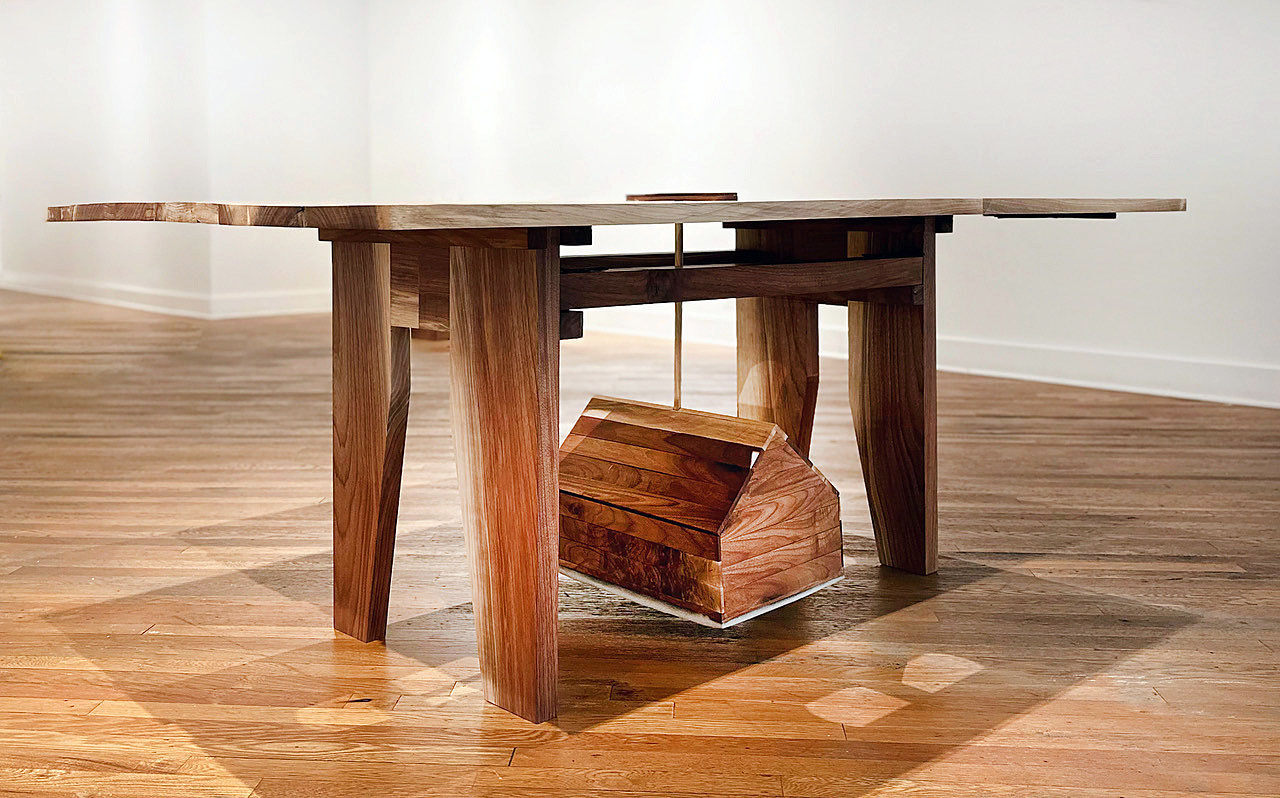
Iris Eichenberg, J.P. Lennepkade 287/289 (Table), Wood, French linen, 30 by 76 ½ by 44 ½ inches, 2023.
It’s worth noting that for all their simplicity, the workmanship on these wooden sculptures is gorgeous, as are their compositional arrangements. An absolute knock-out, even if a total mystery, is J.P. Lennepkade 287/289 (Table), where a house resembling a Monopoly token you’d put on Park Place hangs several inches above the floor, suspended by a wooden dowel and cross-piece hanging from a tidy slot in the middle of a handsomely constructed table.
Interestingly, Eichenberg – an artist of multitudinous talents – milled all the wood that went into Topoanalysis from an old walnut tree that had to be taken down in a friend’s garden.
The artist’s current residence at Cranbrook, designed by Eliel Saarinen, is represented by a squat, gabled affair titled Academy Way that rests on a large, curvaceous piece of bark. (Other houses often sit on a cushion of beige French linen.) As it happens, the bark is not flush with the floor, but has a low “arch” in the center, right where you expect a solid foundation line. Stand back a ways, and you can see light peeking through from the far side.
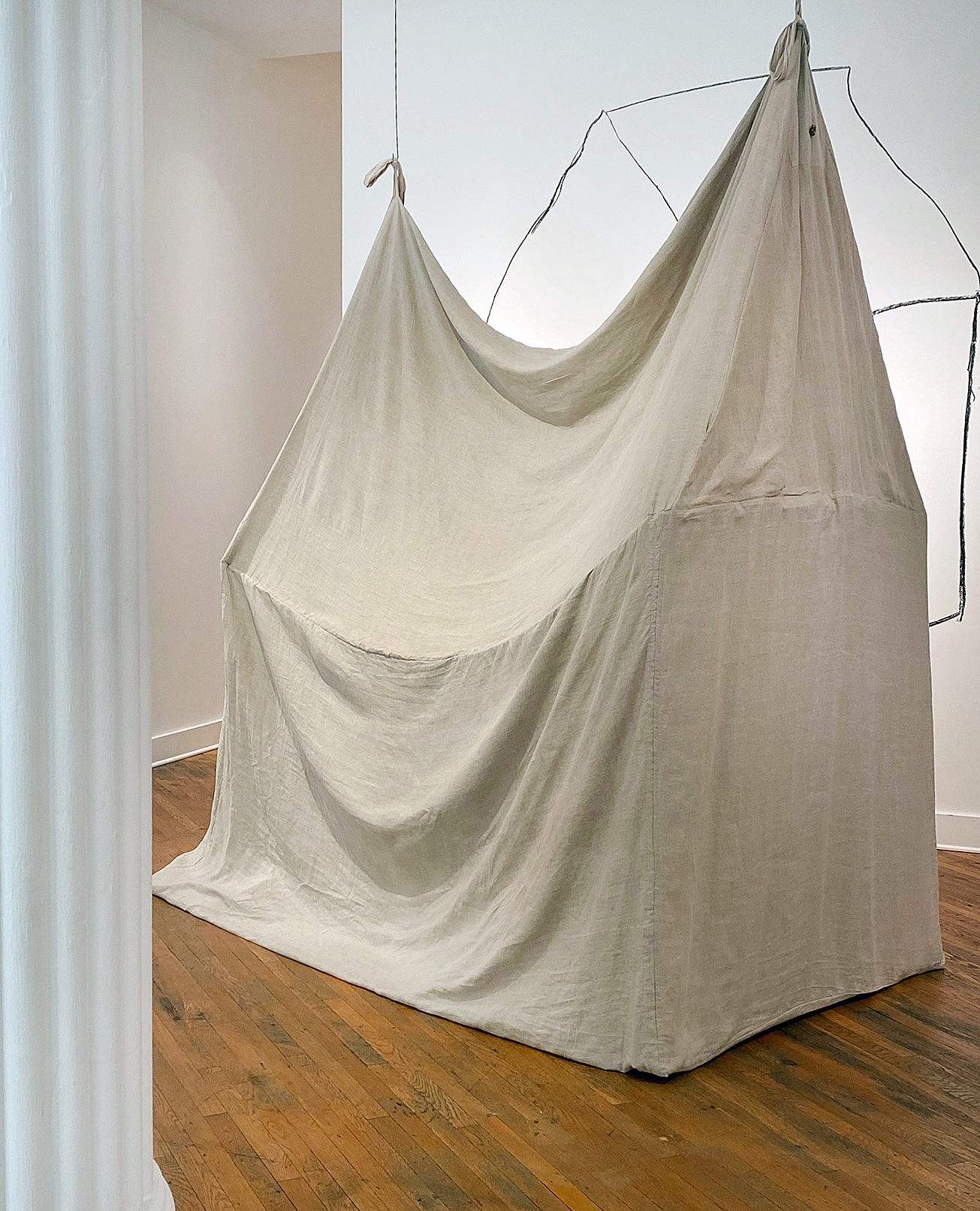
Iris Eichenberg, Wer Bin Eich, French linen, brass weights, charcoal, 100 by 98 by 52 inches, 2023.
Compared to the wood houses, something entirely different is going on with Wer Bin Eich, an eight-foot-tall house built of draped French linen hung from hooks, a little like a quickly erected tent. Of all the works in the show, this is perhaps the most enigmatic, not least because of the rough charcoal sketch facing it on the wall a couple of feet away that echoes its outline in quick, slapdash strokes. If the wooden houses suggest permanence and solidity, Wer Bin Eich trumpets instability and the fragile nature of human constructions.
Peering down at these artifacts are three muted, abstract portraits of friends of Eichenberg’s – Ilse, Ida, and Frida. Their faces are rendered in dribs and drabs of meticulously stitched fabrics, ranging from cheesecloth to horse hair to damask.
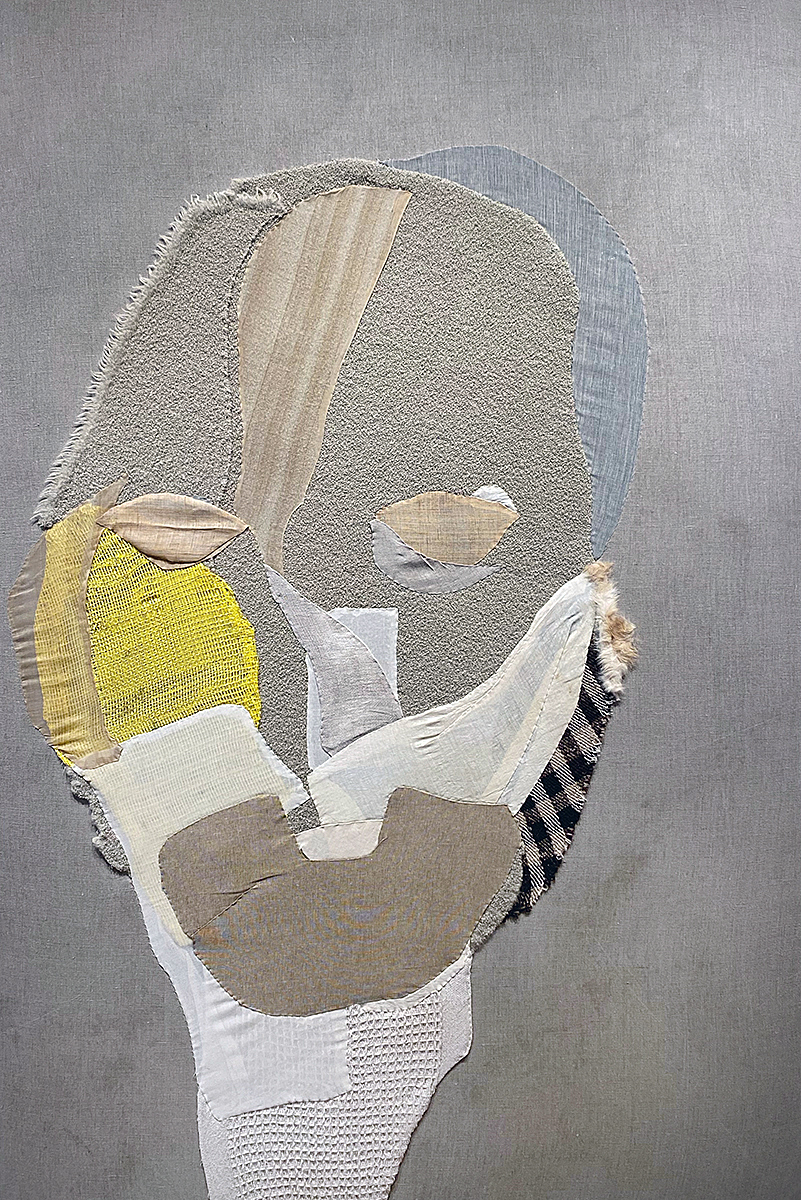
Iris Eichenberg, Ida, French linen, gold linen, cheesecloth, mopcloth, rabbit fur, produce bag, Chinese silk, 72 by 48 inches, 2023.
Finally, the show is capped by a series of nine dark-gray earthenware vessels, some resting on wooden shelves that almost act as frames, and one cozying up to one of her wood houses.
These are not the fine, glossy ceramics Eichenberg’s made in the past. In their slumping and swelling, these primitive, near-black earthenware vessels feel almost organic – like zaftig body parts — with mouths that yearn to talk or pour. It’s hard not to see them as animate little… somethings.
All in all, Topoanalysis is an intriguing, sometimes dizzying mix. As Wayne State art historian Dora Apel wrote in “Essay’d” in 2019, in a comment that applies equally well to this domestic installation, Eichenberg’s work “evokes alienation and dislocation, combined with a sense of yearning for comfort, warmth, and attachment.”
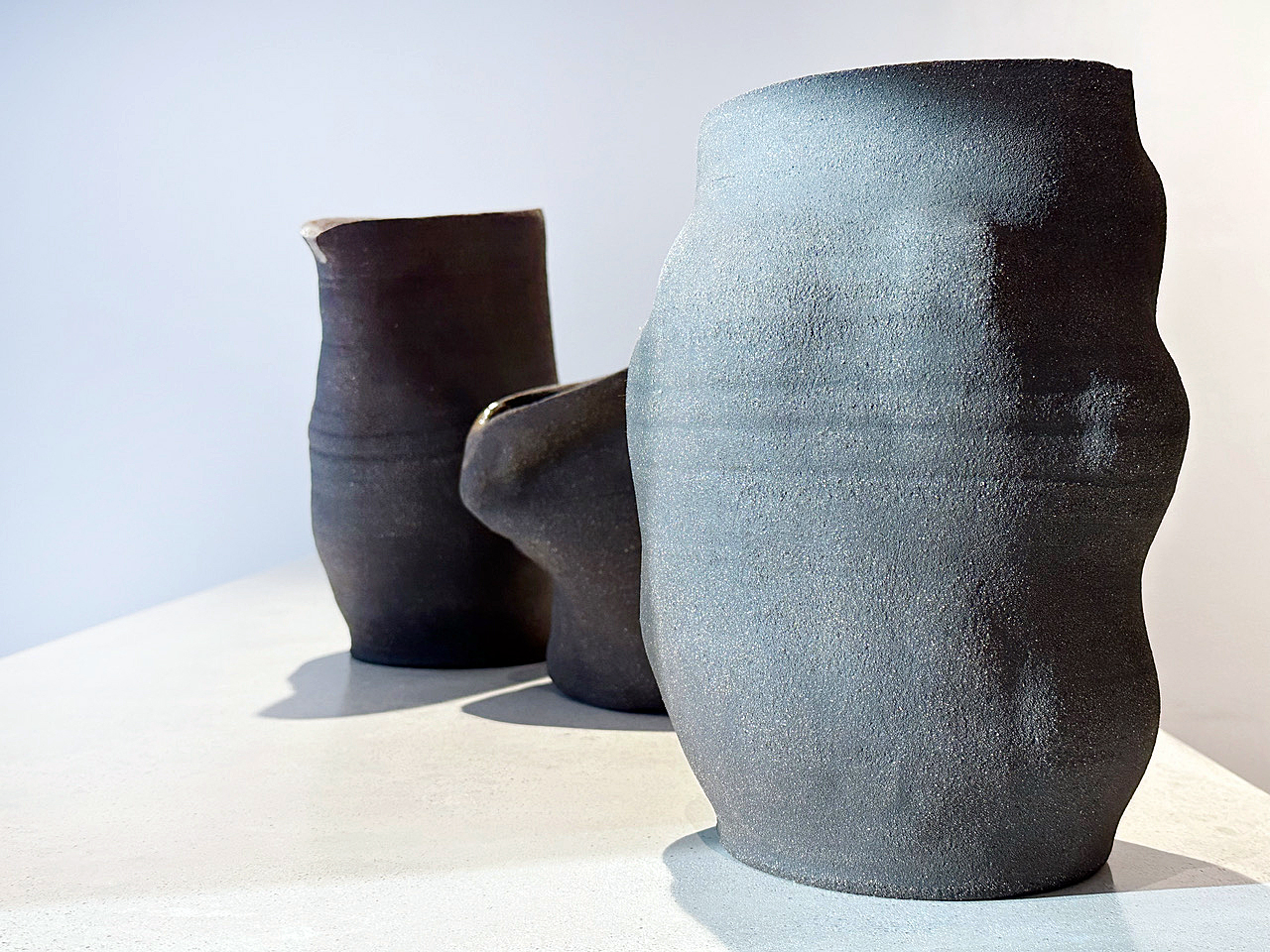
Iris Eichenberg, Black Earthenware Pot, Wood, black earthenware, various dimensions, 2023.
The solo show Iris Eichenberg: Topoanalysis / Wer Bin Ich? will be up at Detroit’s David Klein Gallery through Nov. 4, 2023.
